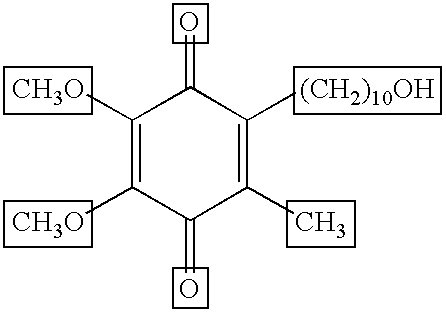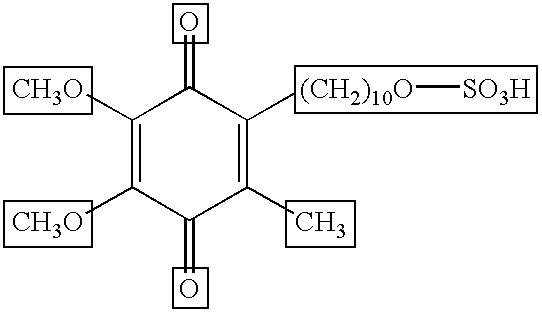Method and preparation for reducing skin hyperpigmentation
a skin hyperpigmentation and preparation technology, applied in the field of skin hyperpigmentation reduction, can solve the problems of allowing significant hyperpigmentation in the skin, known to provide a variety of undesirable effects, etc., and achieve the effect of reducing the occurrence of hyperpigmentation
- Summary
- Abstract
- Description
- Claims
- Application Information
AI Technical Summary
Benefits of technology
Problems solved by technology
Method used
Image
Examples
example 1
[0053] A 0.5% idebenone lotion Formula 1 was prepared as follows:
Formula 1:W / WIngredient (INCI Name)%Water Soluble Ingredients:Purified Water (Aqua)53.83Glycerin10.00Sodium PCA3.00Potato Starch Modified2.00Xanthan Gum0.28Methylparaben0.25Water (and) Titanium Dioxide (C177891) (and) Propylene2.75Glycol (and) Styrene Acrylates Copolymer (and)Hydrolyzed Corn Starch (and) Ammonium Hydroxide(and) Phenoxyethanol (and) Methylparaben (and)Ethylparaben (and) Butylparaben (and) PropylparabenLipid Soluble Ingredients:Isohexadecane2.75Allantoin Glycyrrhetinic Acid0.10Glyceryl Stearate (and) PEG-100 Stearate1.60C30-45 Alkyl Methicone0.50Stearyl Alcohol (and) Ceteareth-202.20Salicyloyl Phytosphingosine0.10Sucrose Cocoate4.29BHT0.15Propylparaben0.15Dimethicone (and) Polysilicone-114.00Glycol Distearate1.50Heat Sensitive Ingredients:Sericin1.50Glycosaminoglycans0.50Acetyl Hexapeptide-34.00Isopropyl Lauroyl Sarcosinate2.00Hydroxydecyl Ubiquinone (Idebenone)0.50Bisabolol0.50Aluminum Starch Octenyls...
example 2
[0059] The idebenone-containing Formula 1 of Example 1 was applied to human skin in a six-week hyperpigmentation study.
[0060] This study used 10 female subjects between the ages of 18 and 65 years who possess moderate skin hyperpigmentation. At the Baseline visit (week 0), all subjects completed an informed consent and a photography consent. Following the consent process, the investigator performed a medical history and examined the appearance of the face to determine the subject's appropriateness for inclusion in the study. Subjects were asked to discontinue their own personally selected hyperpigmentation skin care product(s) and replace them with the test product containing idebenone. A variety of evaluations were performed at baseline, week 3, and week 6. The investigator assessed the subject's facial appearance by rating the subject's level of hyperpigmentation on a 5-point ordinal scale (0=no change; 1=slight; 2=moderate; 3=Marked; and 4=Severe). Additionally, 35 mm photograph...
example 3
[0083] A 1.0% idebenone lotion Formula 2 was prepared as follows:
[0084] Formula 2:
W / WIngredient (INCI Name)%Water Soluble Ingredients:Purified Water (Aqua)53.08Glycerin10.00Sodium PCA3.00Potato Starch Modified2.00Xanthan Gum0.28Methylparaben0.25Water (and) Titanium Dioxide (C177891) (and) Propylene2.75Glycol (and) Styrene Acrylates Copolymer (and)Hydrolyzed Corn Starch (and) Ammonium Hydroxide(and) Phenoxyethanol (and) Methylparaben (and)Ethylparaben (and) Butylparaben (and) PropylparabenLipid Soluble Ingredients:Isohexadecane2.75Allantoin Glycyrrhetinic Acid0.10Glyceryl Stearate (and) PEG-100 Stearate1.60C30-45 Alkyl Methicone0.50Stearyl Alcohol (and) Ceteareth-202.20Salicyloyl Phytosphingosine0.10Sucrose Cocoate4.29BHT0.15Propylparaben0.15Dimethicone (and) Polysilicone-114.00Glycol Distearate1.50Heat Sensitive Ingredients:Sericin1.50Glycosaminoglycans0.50Acetyl Hexapeptide-34.00Isopropyl Lauroyl Sarcosinate2.25Hydroxydecyl Ubiquinone (Idebenone)1.00Bisabolol0.50Aluminum Starch ...
PUM
| Property | Measurement | Unit |
|---|---|---|
| temperature | aaaaa | aaaaa |
| temperature | aaaaa | aaaaa |
| concentration | aaaaa | aaaaa |
Abstract
Description
Claims
Application Information
 Login to View More
Login to View More - R&D
- Intellectual Property
- Life Sciences
- Materials
- Tech Scout
- Unparalleled Data Quality
- Higher Quality Content
- 60% Fewer Hallucinations
Browse by: Latest US Patents, China's latest patents, Technical Efficacy Thesaurus, Application Domain, Technology Topic, Popular Technical Reports.
© 2025 PatSnap. All rights reserved.Legal|Privacy policy|Modern Slavery Act Transparency Statement|Sitemap|About US| Contact US: help@patsnap.com


